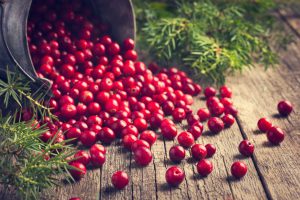Far Beyond Thanksgiving Fare and UTI Remedies
Cranberry Quells Cancer
Written by Katherine A. Carroll, NHF Executive Director, NTP

If we had appreciated how powerful cranberries are against cancers of all kinds, this holiday-associated berry would not be relegated to Thanksgiving or Christmas meals; at least that is the case with many of us. We would be diligent to work cranberries into our daily diet and particularly the seeds, which have 20 times the power of the fruit or juice. Instead of paying a third party for “health insurance” or even the much smarter health sharing, TRUE health insurance begins with these intelligent daily choices that prevent health catastrophes in the first place.
The flowers of this little red power-berry resembled the head of a Sandhill crane thus “cranberries” was the most common early name for what we now know as the common cranberry. The berries’ rich phytonutrient composition, naturally derived plant compounds, particularly proanthocyanidin antioxidants, is chemopreventive and healing with biological properties such as antioxidant, anticancer, anti-neurodegerative, and anti-inflammatory activities. Whichever ways you employ this “health insurance,” do. And expect improvements in immune function, oxidative stress, blood-sugar regulation, decreased infections, reduced cardiovascular disease, blood lipid regulation, and cancer inhibition. All this from a humble berry….
The evergreen cranberry plant is a dwarf, creeping shrub or a low-lying trailing vine. Preferring acidic sandy bogs, cranberries flourish across the temperate and cooler parts of Canada, Europe, and Northern states in the United States. It belongs to the family of Ericaceae, in the genus: Vaccinium, and subgenus: Oxycoccos. The scientific name is Vaccinium macrocarpon. That just sounds like a healthy injection of phytonutrients; the kind of vaccine most of us can handle versus what Big Pharma is foisting on many in rape-like domination today, like it or not.
While most of us are quite familiar with cranberry’s notorious power against urinary tract infections, exhibiting antimicrobial and anti-adhesion activities against gram-positive and gram-negative bacteria, little did some of us suspect that these tart berries are a literal powerhouse against cancer – ovarian, intestinal, colorectal, esophageal, lung, melanoma, renal, bladder, prostate, glioblastoma and lymphoma, and more. A 2015 study proved cranberry’s startling activity against 17 different cancers.[1] In addition to antioxidant and other properties, cranberry flavonoids clearly possess encouraging and proven cancer preventing and cancer-fighting potential.
Cranberries work in various ways to inhibit cancer including cellular-death induction via apoptosis, necrosis and autophagy; reduction of cellular proliferation; alterations in reactive oxygen species; and modification of cytokine and signal transduction pathways.[2] Combining cranberry with various other berries creates a synergistic effect but even alone, the cancer-inhibitory potential of cranberries and cranberry derived products is significant.
Cranberry is a rich source of phenolic constituents and non-digestible fermentable dietary fiber, which shows anti-proliferation effect in colorectal cancer cells[3]. Studying the effect of cranberry powder on mice, intestinal growth of tumors was prevented by 33.1%. Increased apoptosis (cellular death) and a decrease in cell proliferation were observed in tumors of cranberry-fed mice. Additionally, intestinal barrier integrity increased. Other studies show a purified cranberry-derived proanthocyanidin extract, a class of plant-based polyphenols, is a non-toxic, potent inducer of esophageal cell death[4]. With a 20% survival rate after 5 years, esophageal cancer prevention with cranberry is good insurance.
The history of cranberries in the U.S. is interesting; thousands of years past, receding glaciers carved out hollows in the land that grew into cranberry bogs. Once discovered as edible berries, a variety of ways to enjoy cranberries emerged. While some people ate berries fresh, others dried them to make nasampe (grits) or pemmican – a mix of berries, dried meat and animal fat which could last for months. Medicine men, or powwows, used cranberries in traditional healing rituals to fight fever, swelling, and even seasickness[5]. The healing power of (organic) cranberries has been known for centuries.
But make sure your cranberries are organic. Chemical insecticides and fungicides dominate today’s cranberry cultivation. Captain Henry Hall, a veteran of the Revolutionary War, initiated cultivation of the cranberry in 1816 in Massachusetts. Noticing windblown sand made the crops more productive, he implemented this healthy additive, and it was copied, and hopeful growers entered the market steadily throughout the 19th Century. “Cranberry Fever” ensued and ensured that children were even allowed to skip school for harvest in the 1920s in Massachusetts.
There were no chemicals and fungicides being used back then. But by 2015, only 200-300 acres out of the 40,000 then in cultivation in the U.S. were being grown organically. Don’t add to your toxic load by using non-organic cranberries for health. And since we know that cancer feeds on sugar, even consuming organic, heavily sweetened cranberries will give you a false sense of health insurance. Avoid sugar and find an organic grower and in exchange for giving them your support, they will give you a good fighting chance of avoiding cancer, all due to a humble berry relegated in the past for the most part to a holiday feast. Take it far beyond the traditional culinary limitations of our culture and include it daily if you can in many forms.
© 2019 Katherine A. Carroll
[1] Katherine M Weh, Jennifer Clarke, Laura A Kresty, “Cranberries and Cancer: An Update of Preclinical Studies Evaluating the Cancer Inhibitory Potential of Cranberry and Cranberry Derived Constituents,” Antioxidants (Basel). 2016 ;5(3), Epub 2016 Aug 18. PMID: 27548236, at http://www.greenmedinfo.com/article/review-cranberry-research-targeting-cancer-revealed-positive-effects-cranberri
[2] Ibid.
[3] Duochen Jin, Tianyu Liu, Wenxiao Dong, Yujie Zhang, Sinan Wang, Runxiang Xie, Bangmao Wang, Hailong Cao, “Dietary feeding of freeze-dried whole cranberry inhibits intestinal tumor development in Apcmin/+ mice,” Oncotarget, 2017 Nov 17 ;8(58):97787-97800, Epub 2017 Oct 26. PMID: 29228651
[4] Laura A Kresty, Katherine M Weh, Bree Zeyzus-Johns, Laura N Perez, Amy B Howell, “Cranberry proanthocyanidins inhibit esophageal adenocarcinoma in vitro and in vivo through pleiotropic cell death induction and PI3K/AKT/mTOR inactivation,” Oncotarget, 2015 Sep 10. Epub 2015 Sep 10. PMID: 26378019.
[5] “Where Tradition Meets Innovation,” Massachusetts Cranberries, at https://www.cranberries.org/history

Leave a Reply